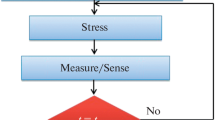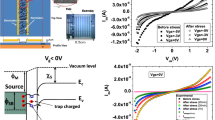Abstract
A novel method, thermally stimulated threshold voltage shift (TSTVS), was introduced to investigate individual trap properties in the gate SiO2 oxide film of submicron p-type metal–oxide–semiconductor field-effect transistors (pMOSFETs). TSTVS measures temperature-dependent threshold voltage shift (∆V th(T)). First, electrical stresses are imposed on a pMOSFET to fill traps with carriers, resulting in ∆V th. Second, the sample temperature is raised at a constant rate. The captured carriers are thermally emitted and ∆V th decreases. The trap properties can be revealed from ∆V th(T). Although TSTVS is similar to the conventional thermally stimulated current (TSC) method, there are several advantages, e.g., higher sensitivity and discrimination ability of carrier polarity. TSTVS was applied to a pMOSFET subjected to electrical stress. The TSTVS signal exhibited several abrupt steps corresponding to individual carrier detrappings, meaning that TSTVS could detect even a single trap. In addition, the carrier polarity was determined by the sign of the steps (upsteps or downsteps). We also revealed the trap energy level through repetitive TSTVS measurements. The presence of two traps in the pMOSFET, i.e., hole and amphoteric traps, was confirmed from these features. We also compared the results with the conventional TSC and found that they could be interpreted by using the proposed atomic structures of traps.






Similar content being viewed by others
References
Shanfield Z. Thermally stimulated current measurements on irradiated MOS capacitors. IEEE Nucl Sci Trans. 1983;30:4064–70.
Fleetwood DM, Lu Z-Y, Nicklaw CJ, Felix JA, Schrimpf RD, Pantelides ST. Unified model of hole trapping, 1/f noise, and thermally stimulated current in MOS devices. IEEE Nucl Sci Trans. 2002;49:2674–82.
Lau WS, Leong LL, Taejoon H, Sandler NP. Detection of oxygen vacancy defect states in capacitors with ultrathin Ta2O5 films by zero-bias thermally stimulated current spectroscopy. Appl Phys Lett. 2003;83:2835–7.
Lakhdari H, Vuillaume D, Bourgoin JC. Spatial and energetic distribution of Si–SiO2 near-interface states. Phys Rev B. 1988;38:13124–32.
Kwon HM, Han IS, Bok JD, Park SU, Jung YJ, Lee GW, Chung YS, Lee JH, Kang CY, Kirsch P, Jammy R, Lee HD. Characterization of random telegraph signal noise of high-performance p-MOSFETs with a high-k dielectric/metal gate. IEEE Electron Dev Lett. 2011;32:686–8.
Wang BC, Wu SL, Lu YY, Chang SJ, Chen JF, Tsai SC, Hsu CH, Yang CW, Chen CG, Cheng O, Huang PC. Comparison of the trap behavior between ZrO2 and HfO2 gate stack nMOSFETs by 1/f noise and random telegraph noise. IEEE Electron Dev Lett. 2013;34:151–3.
Devine RAB, Mathiot D, Warren WL, Fleetwood DM, Aspar B. Point defect generation during high temperature annealing of the Si–SiO2 interface. Appl Phys Lett. 1993;63:2926–8.
Zhang L, Leisure RG. The E δ′ and triplet-state centers in x-irradiated high-purity amorphous SiO2. J Appl Phys. 1996;80:3744–9.
Conley JF Jr, Lenahan PM, Lelis AJ, Oldham TR. Electron spin resonance evidence for the structure of a switching oxide trap: long term structural change at silicon dangling bond sites in SiO2. Appl Phys Lett. 1995;67:2179–81.
Reisinger H, Grasser T, Schlunder C. A study of NBTI by the statistical analysis of the properties of individual defects in pMOSFETS. In: IEEE integrated reliability workshop final report, 2009. pp. 30–35.
Wang T, Chan CT, Tang C-J, Tsai C-W, Wang HC-H, Chi MH, Tang CJ. A novel transient characterization technique to investigate trap properties in HfSiON gate dielectric MOSFETs-from single electron emission to PBTI recovery transient. IEEE Electron Dev Trans. 2006;53:1073–9.
Grasser T, Kaczer B, Goes W, Reisinger H, Aichinger T, Hehenberger P, Wagner P-J, Schanovsky F, Franco J, Luque MT, Nelhiebel M. The paradigm shift in understanding the bias temperature instability: from reaction-diffusion to switching oxide traps. IEEE Electron Dev Trans. 2011;58:3652–66.
Asenov A, Balasubramaniam R, Brown AR, Davies JH. RTS amplitudes in decananometer MOSFETs: 3-D simulation study. IEEE Electron Dev Trans. 2003;50:839–45.
Simmons JG, Tam MC. Theory of isothermal currents and the direct determination of trap parameters in semiconductors and insulators containing arbitrary trap distributions. Phys Rev B. 1973;7:3706–13.
Gaur MS, Rathore BS, Singh PK, Indolia A, Awasthi AM, Bhardwaj S. Thermally stimulated current and differential scanning calorimetry spectroscopy for the study of polymer nanocomposites. J Therm Anal Calorim. 2010;101:315–21.
Leonardi A, Dantras E, Dandurand J, Lacabanne C. Dielectric relaxations in PEEK by combined dynamic dielectric spectroscopy and thermally stimulated current. J Therm Anal Calorim. 2013;111:807–14.
Diogo HP, Ramos JJM. Slow molecular mobility in the amorphous thermoplastic polysulfone A TSDC investigation. J Therm Anal Calorim. 2013;113:773–9.
Yonamoto Y, Inaba Y, Akamatsu N. Detection of nitrogen related traps in nitrided/reoxidized silicon dioxide films with thermally stimulated current and maximum entropy method. Appl Phys Lett. 2011;98:232906.
Stesmans A, Afanas’ev VV. Annealing induced degradation of thermal SiO2: S center generation. Appl Phys Lett. 1996;69:2056–8.
Hiller D, Zierold R, Bachmann J, Alexe M, Yang Y, Gerlach JW, Stesmans A, Jivanescu M, Müller U, Vogt J, Hilmer H, Löper P, Künle M, Munnik F, Nielsch K, Zacharias M. Low temperature silicon dioxide by thermal atomic layer deposition: investigation of material properties. J Appl Phys. 2010;107:064314.
Lelis AJ, Oldham TR, Boesch HE, McLean FB. The nature of the trapped hole annealing process. IEEE Nucl Sci Trans. 1989;36:1808–15.
Lenahan PM, Campbell JP, Kang AY, Liu ST, Weimer RA. Radiation-induced leakage currents: atomic scale mechanisms. Nucl Sci IEEE Nucl Sci Trans. 2001;48:2101–6.
Sushko PV, Mukhopadhyay S, Stoneham AM, Shluger AL. Oxygen vacancies in amorphous silica: structure and distribution of properties. Microelectron Eng. 2005;80:292–5.
Kaczer B, Grasser T, Rousse Ph. J, Franco J, Degraeve R, Ragnarsson L.-A, Simoen E, Groeseneken G, Reisinger H. Origin of NBTI variability in deeply scaled pFETs. In: IEEE international reliability physics symposium, 2010. pp. 2A.3.1-7.
Waltl M, Goes W, Rott K, Reisinger H, Grasser T. A Single-Trap Study of PBTI in SiON nMOS Transistors: Similarities and Differences to the NBTI/pMOS Case. In: IEEE international reliability physics symposium, 2014. pp. XT.18.1-5.
Acknowledgements
I am very grateful to Dr. I. Yamakawa for the setup for the electrical measurements. I also would like to thank Dr. M. Ito for helping me measure the TSC spectra of SiO2.
Author information
Authors and Affiliations
Corresponding author
Rights and permissions
About this article
Cite this article
Yonamoto, Y. Study on individual traps in metal–oxide–semiconductor field-effect transistors by means of thermally stimulated threshold voltage shift. J Therm Anal Calorim 122, 1299–1305 (2015). https://doi.org/10.1007/s10973-015-5097-8
Received:
Accepted:
Published:
Issue Date:
DOI: https://doi.org/10.1007/s10973-015-5097-8




